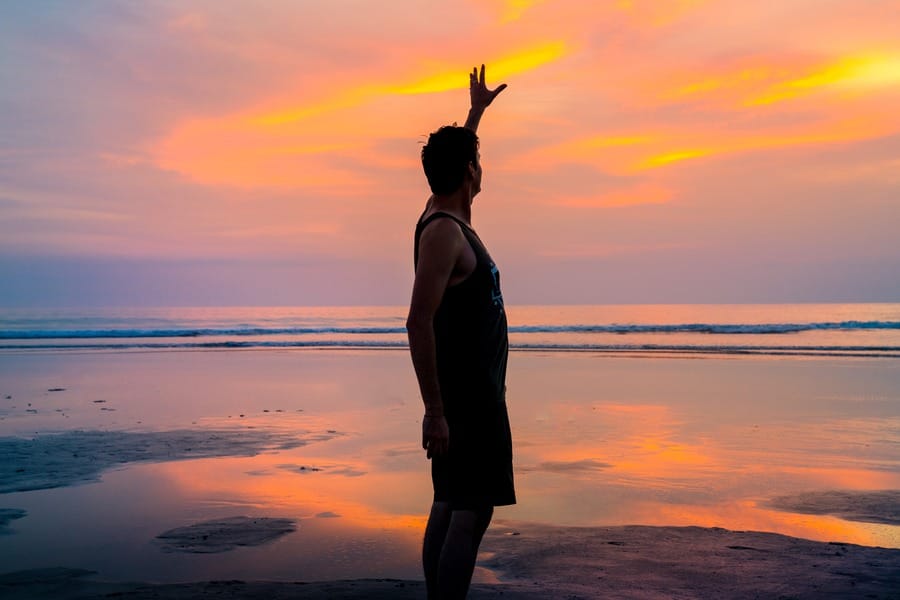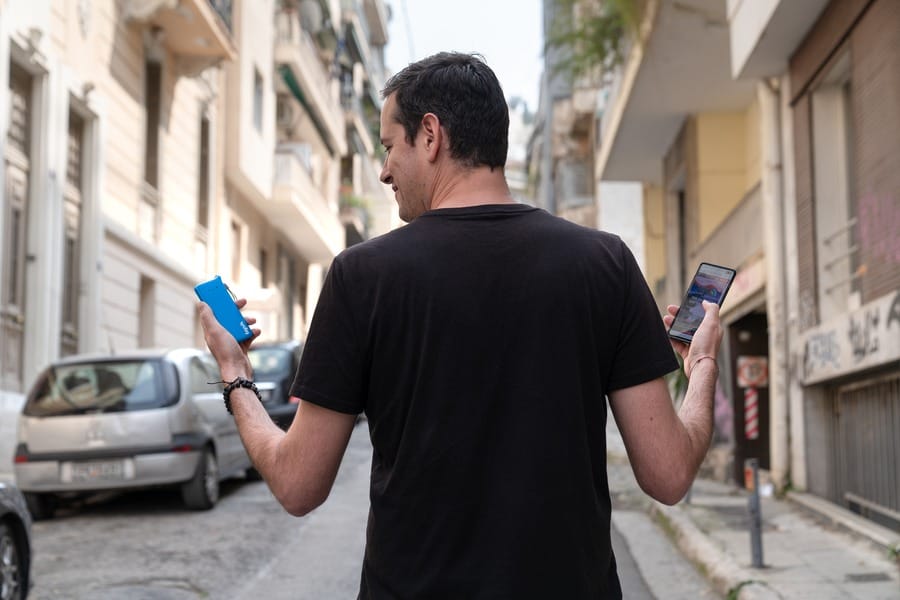Can you guess the number 1 reason why most people don’t travel more?
Money.
Yep, you got it. Not too hard to guess.
Ordinary middle-class folks like you and me can’t take a major international vacation with the money in their back pocket (if you can, share some over here!).
It all starts with a dream and a savings account.
You’re probably overflowing with travel dreams thanks to drool-worthy Instagram posts from far-flung destinations, so how do you get the cash to make the dream happen?
That’s one of the most common questions I get asked. The in-depth answer is as varied and unique as each individual, but there are a few universal strategies that apply to everyone. And this is what I want to share with you.

Let’s start with where your money lives today – the bank. If it’s underneath your mattress, then you don’t have to worry about banking. But I’m guessing that’s not you.
There’s a plethora of websites giving you savings advice on how to drink less takeaway coffee, and cook your own lunches, but I’m focusing on how to get to your dream destination sooner WITHOUT any significant lifestyle changes. And in particular, how to reduce (and preferably eliminate) the cost of managing your own money.
Here’s my 7 favourite banking tips to get you on a plane to your dream travel destination faster.
1. Set your financial goals
The Sound of Music gave us very prudent advice… “Let’s start at the very beginning, a very good place to start”. Saving money for travel is only a worthwhile exercise if there’s a specific goal in mind. That’s your beginning. The goal is what motivates us to push through the discomfort and energises us to reach higher.

So, what’s yours?
Set a travel budget which reflects these things:
- Your desired destination/s (the cost of getting there & relative cost of living)
- Accommodation (how comfy you like to be)
- Activities and tours (the stuff you do on vacation)
- Food (cos everyone’s gotta eat)
- Number of people in your travel group (solo, couple, family, friends)
- Length of trip
Sorry, I can’t pick out a magic number that is perfect for you. Typically, a budget will range between US$1,000 (for ultra-budget solo) to US$5,000 (for mid-range couple). A longer or more luxurious trip could go up to US$10,000 or more.
Use Skyscanner to search for flight costs, Booking.com for accommodation, and Viator for tours. Within about 20-30 minutes you should be able to get a rough budget together.
Choose a financial goal that suits you and, most importantly, is achievable. If you’re barely scratching a living, don’t start by travelling to Bora Bora.
2. Keep a separate travel fund
This is probably the most important part of saving for your travels. A separate bank account allows you to see the progress you’re making, and inspires you to keep going. That momentum will help you resist the urge to tap into your savings on a knee-jerk spending splurge.
While your money is sitting around, put it to work. Choose a bank account that gives you high interest. Sing with me in a Bee Gees falsetto, “I love compound interest!”.
Tip: Varo offers a fee-free bank account and savings account which includes a Visa debit card for day-to-day spending. The account can be connected to Apple Pay, Google Pay and Venmo.

3. Ditch the bank fees!
How much did you spend on bank fees in the last 12 months? If it’s more than zero, then that is too much. Why hand over your hard-earned travel savings to a big bank just for the privilege of holding onto your cash?
Varo is totally fee-free. There’re no catches like a minimum balance or introduction period for new customers. Varo charges zero fees for deposits, withdrawals or point of sale transactions, there’s no monthly fees, and no foreign transaction fees. And that means more money towards your dream trip.

4. Create a savings plan
Money management is a learned skill and chances are you didn’t learn it at school. But it’s never too late to begin.
Put aside a small amount of money from your wage each week or month. The more you can set aside, the faster you’ll save. For example, if you can manage to set aside US$500 per month (about US$115 per week), then your $5,000 goal will be reached in 10 months.
Tip: Setup a high-interest Varo Savings Account which includes a nifty “Save Your Pay” feature. This automatically takes a percentage of your deposits (such as wages) and transfers it to a Savings Account. You choose the percentage, and then it’s completely hands-free. Easy!
Or as an alternative to a piggy bank, “Save Your Change” rounds up every transaction to the nearest dollar and transfers that amount from your Varo Bank Account to your Savings Account. Brilliant!
FYI: Varo pays one of the highest Annual Percentage Yields (APY) of any bank in the United States.
You also get paid up to 2 days earlier with Varo’s Early Direct Deposit feature. This means your money can earn interest longer.

4. No ATM card for travel fund
Avoid linking your travel savings account to a debit card to prevent ATM withdrawals or POS transactions if your willpower is temporarily weak. The buffer of separating your day-to-day spending from travel savings will serve you well in the long-run.

5. Pay off your existing credit card debt
Avoid using credit unless you’re disciplined and pay off your account every month. Yes, credit card points can fast-track your travel rewards, but only if you follow a systematic approach. Take a wrong turn, and you could set your travel dream back years.
If you already find yourself with a credit card debt, start by paying that off first. Whatever benefits you earn from a savings account will be minimal compared to the high interest rate from your credit card.

6. Track your expenses
Use an app like Mint or Wally to track your expenses. Savings only occur when you live below your means. This doesn’t mean you have to be a pauper, but if you don’t track your incomings and outgoings, then it will be very difficult to make your travel dream a reality.

7. Supercharge your savings
Once you have a clear idea of where all your money is going, then it becomes easier to reduce your expenses. Rather than starting with the big, scary ones, start with the small easy ones.
Do you really need an Apple Music and Amazon Unlimited Music subscription? $10 saved. What about that gym membership that you never use? $40 saved. It all adds up and before you know it, you’ve been able to bump your monthly savings from $500 to $600. That equates to flying off into the sunset almost 2 months earlier than before!
Take your savings to the next level and simplify your life. I hate to use the cliché Starbucks coffee example, but it’s true. It’s not about getting rid of the things you love, but looking for ways to enjoy them in a more cost-effective way. Brewing your own coffee at home takes only a few minutes and is a fraction of the cost.
When you take a hard, honest look at your expenses (from the previous point), you’ll find fat to trim. Even expenses that might seem necessary can have cheaper alternatives – like car and health insurance (do some shopping around), mortgage repayments (switching banks can save thousands), or cell phone plans (do you really need support for international roaming in Kazakhstan?)
Show your expense list to a trusted friend or family member, and ask them to pick it apart. Tell them to be ruthless. Their questions may be enlightening by helping you look at your expenses from a fresh perspective.
And finally, take a swing at de-cluttering your home. It’s beneficial for your mental wellbeing and helps your travel savings kitty too. Sell your unwanted or unused sports gear, golf clubs, tennis rackets, comic book collection, old phones, or designer shoes on eBay, Craigslist, Wallapop or LetGo. You might actually enjoy it!

Varo Tips:
I’ve mentioned Varo’s neathigh-interest Varo Savings Account in this article which makes saving for your vacation much, much easier. Here’s a few more things to be aware of:
- Varo accounts are only available for U.S. citizens and permanent residents who are 18 or older with a valid social security number.
- Varo currently does not support joint accounts or business accounts. However, if you’re running a side business and want to use your Varo account as a way to receive your pay, this is still considered an “individual” account.
The Varo app is available for iOS and Android.
Kickstart your travel dream with a Varo Savings Account. No fees, early direct deposit, auto savings tools and high interest rates. Check it out at varomoney.com.












Write Your Comment
Please DO NOT include links, URLs or HTML in your comments - they will be automated deleted and you will waste your time.